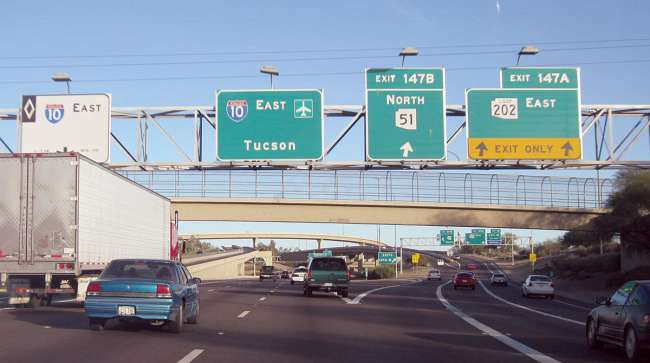Staff Reporter
Arizona DOT Installs Truck-Screening Technology to Improve Commerce

[Stay on top of transportation news: Get TTNews in your inbox.]
In an effort to improve the flow of freight, the Arizona Department of Transportation has installed technology that screens moving trucks at several ports of entry.
ADOT added the technology, which records weight and identification information, at commercial ports of entry along interstates 10 and 40 and state Route 95. Interstates 10 and 40 are major east-west routes, passing through Arizona to connect California and New Mexico. Split into two sections, state Route 95 creeps up Arizona’s borders with California and Nevada.
“As you’re coming from New Mexico or California on either I-10 or I-40, you’ll go through these truck-screening places,” ADOT spokesman Ryan Harding said. “There’s a lot of truck traffic on those interstates.”
The technology includes weigh-in-motion sensors, message signs and cameras that can read U.S. Department of Transportation numbers and license plates. As a truck approaches a port of entry, highway signs direct the driver to the right lane. When the truck is a half-mile from the port, the sensors and cameras capture the vehicle’s information and transmit it to the ADOT Enforcement and Compliance Division officers posted at the port.
Harding explained that the cameras and the sensors, which are embedded in the roadway, are designed to collect information without the truck needing to stop.
“The cameras are really high-speed, so they can capture the U.S. DOT number and the license plate, and it’s able to weigh the truck as it rolls right over,” Harding said.
NEW: To help freight move efficiently while ensuring that commercial vehicles can operate safely, ADOT has expanded its use of technology that screens moving trucks for weight and identifying information. MORE: https://t.co/lN384XOQO4 pic.twitter.com/8z4mM6btoN — Arizona DOT (@ArizonaDOT) June 24, 2020
A computer verifies the truck’s credentials using national and state databases. If the truck is cleared and doesn’t violate weight limits, the message boards along the highway direct the driver to proceed on his or her trip. If there is an issue, such as an expired registration or out-of-service order, the signs prompt the driver to pull into the port for further inspection.
“It just makes it more efficient because the trucks coming into the port are those trucks that need further inspection by officers, and the trucks that are OK can just continue right on,” Harding said. “It kind of smooths the flow of commerce.”

COVID-19 has changed the rules of business, disrupted supply chains and created market volatility. Host Seth Clevenger revisits interviews with a broad range of industry experts and their evolving response to the pandemic. Hear a snippet, above, and get the full program by going to RoadSigns.TTnews.com.
At the Ehrenberg and San Simon ports of entry, which sit along I-10 on opposite sides of the state, the technology also features identification capabilities meant for truck tires that may be damaged. Harding explained that tire sensors were installed at these locations to function as a sort of pilot program for ADOT. He said the agency will evaluate how well the sensors work and assess options to expand their use.
ADOT’s installation of the sensors along the interstates and state Route 95 marks an expansion. Previously, the truck-screening technology had been in place at certain locations, including the Sacaton and Canoa Ranch rest areas. The technology at these locations will remain in place.
The technology is meant to save ADOT officers and truck drivers time. Additionally, the system tracks and stores size and weight information for trucks entering Arizona. This data is meant to help ADOT’s Multimodal Planning Division make decisions about the highway system in the future.
“We hope that this will make it a lot more efficient for the flow of commerce in and out of the state,” Harding said, “and make it more efficient for our officers’ time and resources as well by only inspecting trucks that need it.”
Want more news? Listen to today's daily briefing:
Subscribe: Apple Podcasts | Spotify | Amazon Alexa | Google Assistant | More




